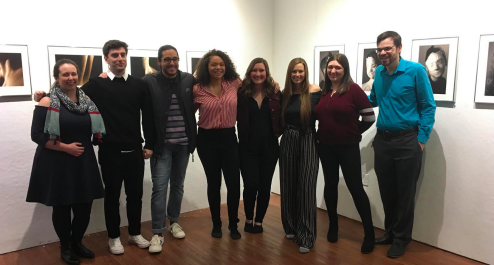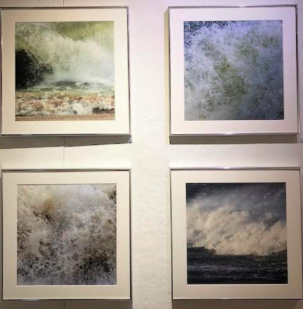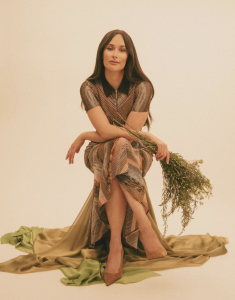By Shannon Miller
Staff Writer
Excitement filled the S.A.L. Gallery on Nov. 28, as the students of Professor Justin Capalbo’s photo 7 class celebrated the opening night of their exhibition “Arcane.”
The exhibit’s title means understood by few, mysterious or secret; a translation that gave the show an underlying theme. Each student chose four photographs to represent their unique interpretation of the word’s definition.

Ciminelli, Ashley Wilson, Crystal Gonzalez, and Professor Justin Capalbo
The class came up with “Arcane” together, according to Capalbo. “For their first three years in the photo program, they were really working independently on their work,” he said. “This exhibit is just to figure out how to kind of put egos aside, work together, and create a cohesive body of work all around one topic.”
Senior photography major, Ashley Wilson, called her series “Unknown” which captured the notion that it’s really what’s inside a person that counts. The photos are portraits of model’s faces covered with paper towels soaked in water. A hidden face makes it difficult to determine who someone is. “Nowadays, everyone is so focused on what people look like; and in typical portraits you have to look pretty,” she said. “I figured cover the face, and really, you have to decide if you like the person through other features, instead of paying attention to their makeup or something on their face.”
Also focused on obscureness of the human body was junior photography major, Jessica Ciminelli. Her untitled series left it to the observer to guess which part of the body is used in each print. Creating the mystery she emitted was her use of light.
Drew Esposito, Ciminelli’s cousin, admired the second photo for its darkness and light. “It’s kind of mysterious if you didn’t know it was a person’s back,” he said. “The background in contrast to the rest of the picture, and the color is really nice. And the spaces on the body that are darker naturally are really cool,” Cecelia Filriello, a friend of Ciminelli’s, said.
Her last photo showed the curve of the body where the back of the neck meets the spine. It left viewers questioning what they were looking at. Even Cara Giannetto, the model featured in the photo, was uncertain herself during the shoot. “When I was bent over, I was just trying to figure out how she was going to make it into a picture, but it came out really cool,” she said.
Senior fine arts major, Jeffrey Gomez, took the idea of obscuring and restricting to another level. He worked with a favorite sculpture of his by French artist, Auguste Rodin, displayed at the Metropolitan Museum of Art. “I go to the MET religiously, I go almost every Sunday just to write, and view and admire work,” Gomez said.
It took over twenty rolls of film, as well as several trips to the museum, to get the 15 shots that make up his series. Gomez moved around the sculpture taking photos with a long exposure to create “rich black tones and movement.”
The photos are shot on black & white film and developed in a dark room. “That’s kind of just my thing. I like keeping things analogue cause there is just a feel; there’s a grit to it; there’s grain that you can’t really achieve that well in digital [photography],” Gomez said. “I really wanted to just capture light, shadow, and black; like really dark pieces. Generally, when I do a lot of paintings, they’re a more darker tone; there is a more nihilistic feel to them; and I try to achieve that in photos when photographing a subject with long exposures.”
Senior photography major, Chloe Rosario, worked with long exposures as well. She titles her series, “La Ilusion También Se Vive” which means “The Illusion Also Lives.”

of the word “Arcane”
At first, Rosario was confused how to demonstrate her understanding of arcane. “I actually looked up the word, and looked at images, and I saw this woman. It was a random photo, and she had a white sheet hanging over her, but not on her. It had her shadow; her silhouette,” Rosario said. “I wanted to do something just like that, but make it look more deep. I wanted it to have more of a meaning.”
In her four photos she used plexiglass instead of a sheet because it was more mobile. Using it to hide her model’s faces made it easier to get her point across. “I had my model lean the plexiglass against the table, but tried to show she was trying to reach out,” she said. Her four photos captured outlines and silhouettes that gave the viewer a feeling of obstruction.
Offering a less intricate impression with her photos was senior photography major, Crystal Gonzalez. She concentrated on the restriction aspect of arcane. When the class was told they could restrict their vision to a part of something, she began her project at the beach.

“After a couple of windy days I started getting like a splash effect. So, then I focused on just the wave and cropped in,” Gonzalez said. “It’s restricting the viewer to only this. You know? There’s a whole beach but I’m making them look at this.”
Gonzalez chose the ocean because many people go there to escape or reflect on life. She wanted observers to take a breather from the heavy focus her classmates were working with. “At the same time though, I also wanted to make it fit in with their emotion. Everybody else’s has movement, and I have movement. You know? The water moves and it splashes,” she said.
MFA student, Lauren Bourguet, a conceptual artist who is more interested in presenting an idea rather than a physical piece of art, worked intensely with movement. She also used a slow shutter speed which allowed the lens to remain open longer; therefore, creating the look of movement in the model’s motions.

Over 500 photos were shot in Lorber Hall, which she narrowed down to four prints for the exhibit. The location gave her series an “organic feel” since the show was also presented on campus, according to Bourguet.
As viewers stopped at her remaining three photos, the model appeared to be paging through a book, which Bourguet said, was meant to be a metaphor for a solution. “She [the model] wants to be fully enveloped in the pages and transform them into her life. You can sort of translate this book in a religious term. You can translate it in a medical term. [It’s] that idea of finding a solution when you’re in a dark place,” side said.
Each photographer successfully portrayed what “arcane” means to them in an abstract form. During the creative process, the students critique each other’s prints, which allowed them as a group, to make decisions and changes to their prints.
“When students eventually take photo 7, they have already developed their own styles. This show required a collaborative effort which obligated them to lose full control over their photos,” Capalbo said.




Be First to Comment